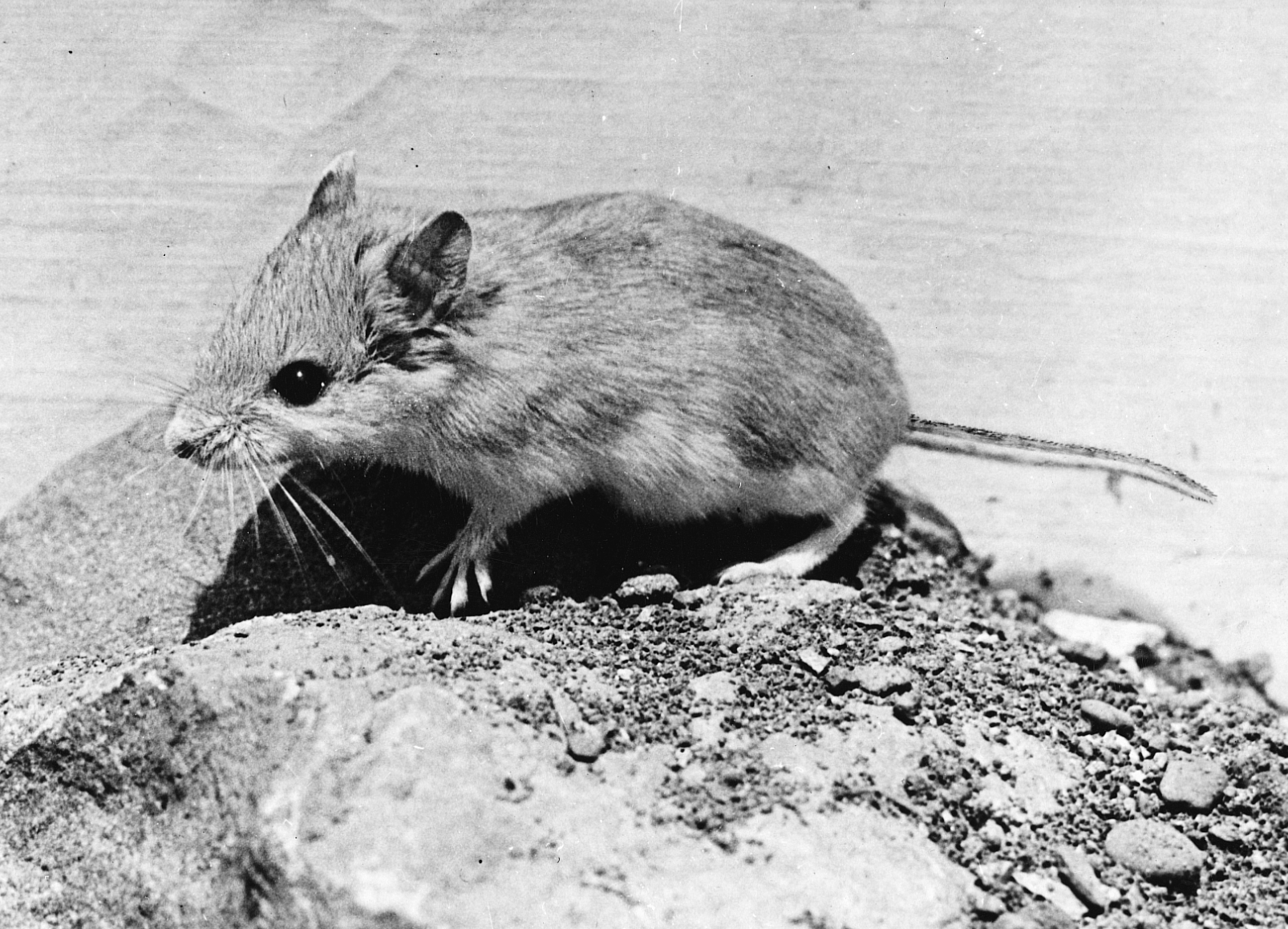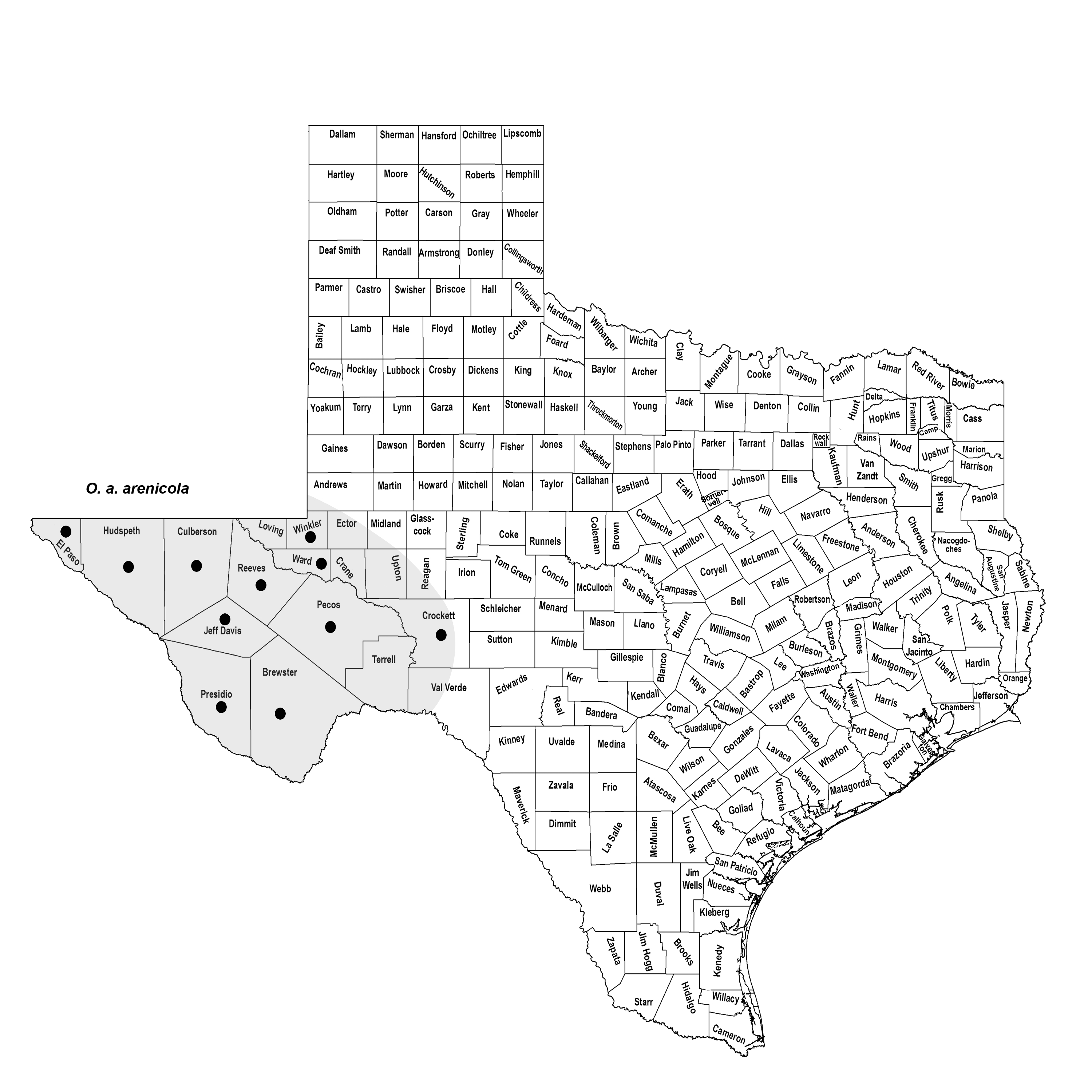CHIHUAHUAN OR MEARNS'S GRASSHOPPER MOUSE
Onychomys arenicola Mearns 1896
Order Rodentia : Family Cricetidae
DESCRIPTION. A small, fat-tailed mouse with pinkish cinnamon or grayish buff upperparts and pure white underparts; usually a conspicuous white or grayish tuft at anterior base of ear; nose, cheeks, and sides white; tail sparsely haired, >30% of total length, 2–2.5 times as long as hind foot and distinctly bicolor, dark above and white below. Similar to O. leucogaster but smaller, with relatively longer tail and smaller teeth. Juveniles similar to adults but upperparts bluish gray. Dental formula: I 1/1, C 0/0, Pm 0/0, M 3/3 × 2 = 16. Averages for external measurements: total length, 146 mm; tail, 52 mm; hind foot, 21 mm. Weight of males, 26.5 g (24–30 g); of females, 25 g (22–28 g).

DISTRIBUTION. Throughout the Trans-Pecos and a few counties east of the Pecos
River.

SUBSPECIES. Onychomys a. arenicola.
HABITS. This mouse inhabits the low, arid, sandy or gravelly desert areas where desert scrub vegetation, such as creosote bush, mesquite, yucca, lechuguilla, and condalia, is sparse and scattered. It lives in burrows of its own or in those it commandeers from other small rodents. Like the northern grasshopper mouse, it is relatively rare in most localities.
Its behavior and feeding habits are similar to those outlined for O. leucogaster.
Breeding begins in late January or early February and continues into September. Pregnant
females have been captured as early as 27 February and as late as 5 September. The
litters vary in size from two to seven (average 4.2). Half-grown pups have been captured
in April, June, July, and August, suggesting that two or even three litters are produced
each year. The pups grow rapidly, and females become sexually mature when 7 or 8 weeks
of age. A young female can give birth to her first litter at the age of 4 months.
The gestation period is 27–30 days.
Onychomys arenicola is active at night, when it forages for insects. Additional food items include other arthropods, especially scorpions, and small mammals. In 1997 at Big Bend Ranch State Park, Frank Yancey (Reedley College) witnessed a Mearns's grasshopper mouse killing and feeding on a medium-sized kangaroo rat.
These mice are vocal and often emit high-pitched chirps or howls when foraging in an area. They are highly territorial, and their vocalizations may help to identify species territories and reduce antagonistic encounters with conspecifics.
POPULATION STATUS. Common. Although infrequently encountered, Mearns's grasshopper mouse is common throughout much of the Trans-Pecos region.
CONSERVATION STATUS. The IUCN lists Mearns's grasshopper mouse as a species of least concern, and it does not appear on the federal or state lists of concerned species. It appears to be in good shape throughout its range in Texas and does not seem to have any serious conservation threats.
From The Mammals of Texas, Seventh Edition by David J. Schmidly and Robert D. Bradley, copyright © 1994, 2004, 2016. Courtesy of the University of Texas Press.
Natural Science Research Laboratory
-
Address
Museum of Texas Tech University, 3301 4th street, Lubbock, TX 79409 -
Phone
806.742.2486 -
Email
nsrl.museum@ttu.edu

